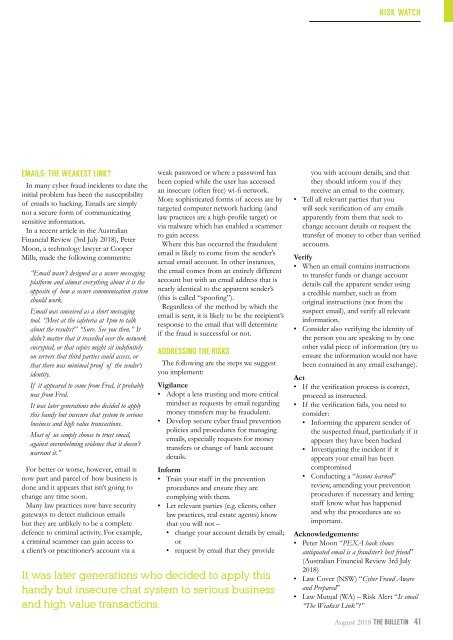The Bulletin August 2018
You also want an ePaper? Increase the reach of your titles
YUMPU automatically turns print PDFs into web optimized ePapers that Google loves.
RISK WATCH<br />
EMAILS: THE WEAKEST LINK?<br />
In many cyber fraud incidents to date the<br />
initial problem has been the susceptibility<br />
of emails to hacking. Emails are simply<br />
not a secure form of communicating<br />
sensitive information.<br />
In a recent article in the Australian<br />
Financial Review (3rd July <strong>2018</strong>), Peter<br />
Moon, a technology lawyer at Cooper<br />
Mills, made the following comments:<br />
“Email wasn’t designed as a secure messaging<br />
platform and almost everything about it is the<br />
opposite of how a secure communication system<br />
should work.<br />
Email was conceived as a short messaging<br />
tool. “Meet at the cafeteria at 1pm to talk<br />
about the results?” “Sure. See you then.” It<br />
didn’t matter that it travelled over the network<br />
encrypted, or that copies might sit indefinitely<br />
on servers that third parties could access, or<br />
that there was minimal proof of the sender’s<br />
identity.<br />
If it appeared to come from Fred, it probably<br />
was from Fred.<br />
It was later generations who decided to apply<br />
this handy but insecure chat system to serious<br />
business and high value transactions.<br />
Most of us simply choose to trust email,<br />
against overwhelming evidence that it doesn’t<br />
warrant it.”<br />
For better or worse, however, email is<br />
now part and parcel of how business is<br />
done and it appears that isn’t going to<br />
change any time soon.<br />
Many law practices now have security<br />
gateways to detect malicious emails<br />
but they are unlikely to be a complete<br />
defence to criminal activity. For example,<br />
a criminal scammer can gain access to<br />
a client’s or practitioner’s account via a<br />
weak password or where a password has<br />
been copied while the user has accessed<br />
an insecure (often free) wi-fi network.<br />
More sophisticated forms of access are by<br />
targeted computer network hacking (and<br />
law practices are a high-profile target) or<br />
via malware which has enabled a scammer<br />
to gain access.<br />
Where this has occurred the fraudulent<br />
email is likely to come from the sender’s<br />
actual email account. In other instances,<br />
the email comes from an entirely different<br />
account but with an email address that is<br />
nearly identical to the apparent sender’s<br />
(this is called “spoofing”).<br />
Regardless of the method by which the<br />
email is sent, it is likely to be the recipient’s<br />
response to the email that will determine<br />
if the fraud is successful or not.<br />
ADDRESSING THE RISKS<br />
<strong>The</strong> following are the steps we suggest<br />
you implement:<br />
Vigilance<br />
• Adopt a less trusting and more critical<br />
mindset as requests by email regarding<br />
money transfers may be fraudulent.<br />
• Develop secure cyber fraud prevention<br />
policies and procedures for managing<br />
emails, especially requests for money<br />
transfers or change of bank account<br />
details.<br />
Inform<br />
• Train your staff in the prevention<br />
procedures and ensure they are<br />
complying with them.<br />
• Let relevant parties (e.g. clients, other<br />
law practices, real estate agents) know<br />
that you will not –<br />
• change your account details by email;<br />
or<br />
• request by email that they provide<br />
It was later generations who decided to apply this<br />
handy but insecure chat system to serious business<br />
and high value transactions.<br />
you with account details, and that<br />
they should inform you if they<br />
receive an email to the contrary.<br />
• Tell all relevant parties that you<br />
will seek verification of any emails<br />
apparently from them that seek to<br />
change account details or request the<br />
transfer of money to other than verified<br />
accounts.<br />
Verify<br />
• When an email contains instructions<br />
to transfer funds or change account<br />
details call the apparent sender using<br />
a credible number, such as from<br />
original instructions (not from the<br />
suspect email), and verify all relevant<br />
information.<br />
• Consider also verifying the identity of<br />
the person you are speaking to by one<br />
other valid piece of information (try to<br />
ensure the information would not have<br />
been contained in any email exchange).<br />
Act<br />
• If the verification process is correct,<br />
proceed as instructed.<br />
• If the verification fails, you need to<br />
consider:<br />
• Informing the apparent sender of<br />
the suspected fraud, particularly if it<br />
appears they have been hacked<br />
• Investigating the incident if it<br />
appears your email has been<br />
compromised<br />
• Conducting a “lessons learned”<br />
review, amending your prevention<br />
procedures if necessary and letting<br />
staff know what has happened<br />
and why the procedures are so<br />
important.<br />
Acknowledgements:<br />
• Peter Moon “PEXA hack shows<br />
antiquated email is a fraudster’s best friend”<br />
(Australian Financial Review 3rd July<br />
<strong>2018</strong>)<br />
• Law Cover (NSW) “Cyber Fraud Aware<br />
and Prepared”<br />
• Law Mutual (WA) – Risk Alert “Is email<br />
“<strong>The</strong> Weakest Link”?”<br />
<strong>August</strong> <strong>2018</strong> THE BULLETIN 41


















